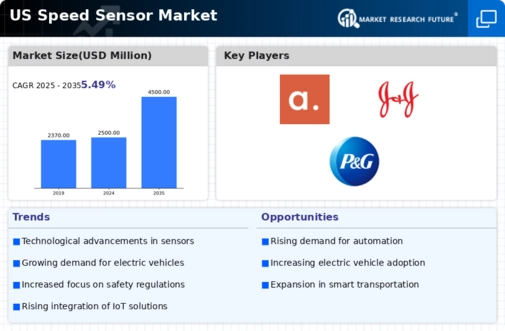Advancements in Sensor Technology
Technological advancements in sensor technology are reshaping the speed sensor market. Innovations such as MEMS (Micro-Electro-Mechanical Systems) and IoT (Internet of Things) integration are enhancing the capabilities of speed sensors, making them more accurate and efficient. These advancements allow for real-time data collection and analysis, which is crucial for applications in automotive and industrial sectors. The integration of smart technologies is expected to boost the speed sensor market, as manufacturers seek to leverage these innovations for improved performance. As the demand for high-precision sensors continues to grow, the speed sensor market is likely to see significant advancements in technology and application..
Expansion of Industrial Automation
the speed sensor market benefits from the rapid expansion of industrial automation across various sectors.. Industries such as manufacturing, logistics, and energy are increasingly adopting automated systems to enhance operational efficiency. Speed sensors play a crucial role in monitoring and controlling machinery, ensuring optimal performance and reducing downtime. The industrial sector is projected to account for around 25% of the speed sensor market, reflecting a growing reliance on automation technologies. As companies seek to improve productivity and reduce operational costs, the demand for reliable speed sensors is likely to increase, driving further growth in the speed sensor market.
Increased Focus on Fuel Efficiency
the speed sensor market is driven by the heightened focus on fuel efficiency in the automotive sector.. As fuel prices fluctuate, consumers and manufacturers alike are prioritizing technologies that enhance fuel economy. Speed sensors are integral to various systems that optimize engine performance and reduce fuel consumption. Recent studies indicate that vehicles equipped with advanced speed sensing technologies can achieve up to 15% better fuel efficiency. This growing emphasis on sustainability and cost-effectiveness is likely to propel the speed sensor market, as manufacturers strive to meet consumer demands for more efficient vehicles.
Growth of Electric and Hybrid Vehicles
The transition towards electric and hybrid vehicles is significantly influencing the speed sensor market. As the automotive industry shifts focus to sustainable transportation solutions, the demand for speed sensors in electric and hybrid vehicles is expected to rise. These vehicles require precise speed measurements for optimal performance and energy efficiency. Recent statistics suggest that electric vehicle sales in the US have increased by over 30% in the past year, further propelling the need for advanced speed sensing technologies. This shift not only enhances the performance of electric vehicles but also contributes to the overall growth of the speed sensor market, as manufacturers adapt to the evolving landscape of automotive technology.
Rising Demand for Automotive Safety Features
The speed sensor market is experiencing a notable surge in demand driven by the increasing emphasis on automotive safety features. As consumers become more safety-conscious, manufacturers are integrating advanced speed sensors into vehicles to enhance functionalities such as adaptive cruise control and collision avoidance systems. According to recent data, approximately 60% of the speed sensor market is accounted for by the automotive sector., indicating a robust growth trajectory. This trend is further supported by the implementation of stringent safety regulations, compelling automakers to adopt innovative technologies. Consequently, the speed sensor market is poised for expansion, aligning with the growing consumer preference for safer vehicles..













Leave a Comment